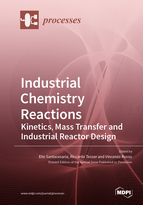Industrial Chemistry Reactions: Kinetics, Mass Transfer and Industrial Reactor Design
A special issue of Processes (ISSN 2227-9717). This special issue belongs to the section "Chemical Processes and Systems".
Deadline for manuscript submissions: closed (31 July 2021) | Viewed by 49133
Special Issue Editors
Interests: kinetics; catalysis; reactor design and simulation; separation science
Special Issues, Collections and Topics in MDPI journals
Interests: heterogenous catalysis; biomass transformation; green chemistry kinetics; mass transfer and industrial reactors
Special Issues, Collections and Topics in MDPI journals
Interests: chemical reaction engineering; kinetics; catalysis; reactor; modeling
Special Issues, Collections and Topics in MDPI journals
Special Issue Information
Dear Colleagues,
The impressive progress of commercially available computers allows us nowadays to solve complicated mathematical problems in many scientific and technical fields. This revolution has reinvigorated chemical engineering science in all its compartments. More sophisticated approaches to catalysis, kinetics, reactor design and simulation have been developed thanks to the newly available powerful calculation methods. It is well known that many chemical reactions are of great interest for industrial processes and must be conducted on a large-scale in order to get needed information in thermodynamics, kinetics, and transport phenomena related to mass, energy, and momentum. For a reliable industrial-scale reactor design, all this information must be employed in appropriate equations and mathematical models that allow for accurate and reliable simulations for the purposes of scaling up. The aim of this proposed Special Issue is to collect worldwide contributions from experts in the field of industrial reactor design based on kinetic and mass-transfer studies. The following areas/sections will be covered by the call for original papers:
- Kinetic studies for complex reaction schemes (multiphase systems)
- Kinetics and mass transfer in multifunctional reactors
- Reactions in mass-transfer dominated regime (fluid-solid and intraparticle diffusive limitations)
- Kinetics and mass-transfer modeling with alternative approaches (ex. stochastic modeling)
- Pilot plant and industrial size reactors simulation and scale-up based on kinetic studies (lab-to-plant approach)
Prof. Riccardo Tesser
Prof. Dr. Vincenzo Russo
Guest Editors
Manuscript Submission Information
Manuscripts should be submitted online at www.mdpi.com by registering and logging in to this website. Once you are registered, click here to go to the submission form. Manuscripts can be submitted until the deadline. All submissions that pass pre-check are peer-reviewed. Accepted papers will be published continuously in the journal (as soon as accepted) and will be listed together on the special issue website. Research articles, review articles as well as short communications are invited. For planned papers, a title and short abstract (about 100 words) can be sent to the Editorial Office for announcement on this website.
Submitted manuscripts should not have been published previously, nor be under consideration for publication elsewhere (except conference proceedings papers). All manuscripts are thoroughly refereed through a single-blind peer-review process. A guide for authors and other relevant information for submission of manuscripts is available on the Instructions for Authors page. Processes is an international peer-reviewed open access monthly journal published by MDPI.
Please visit the Instructions for Authors page before submitting a manuscript. The Article Processing Charge (APC) for publication in this open access journal is 2400 CHF (Swiss Francs). Submitted papers should be well formatted and use good English. Authors may use MDPI's English editing service prior to publication or during author revisions.
Keywords
- reactor design and simulation
- kinetics of chemical reactions
- complex reactions
- multiphase systems
- multi-functional reactors
- transport phenomena








